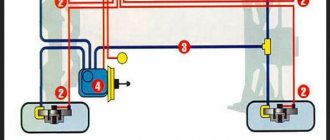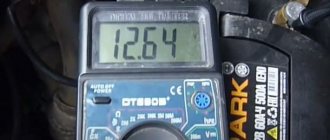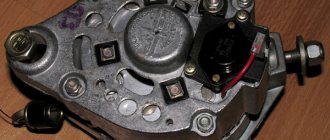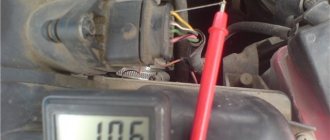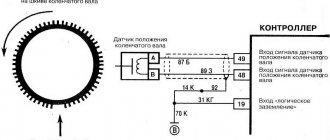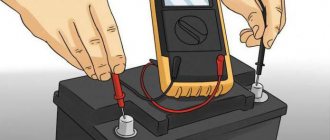When the car does not start for unknown reasons, you need to check the vehicle mass. The most convenient way is to use a multimeter. It's done like this:
- The voltage on the device is set to 2 V.
- One probe of the multimeter is connected to the vehicle body. The most cleared place is selected.
- The second dipstick is located on the engine.
- Readings are taken from the device.
The ground is considered weak if the number 1 V lights up on the display. To verify the weak strength, place one wire of the device on the negative terminal of the battery, and connect the second to the engine. Inflated data will indicate poor-quality mass contact.
How to find plus or minus with a multimeter on a car
The wires on the machine are painted a specific color for identification. In some cases, it is not always possible to determine the location of the positive and negative place. Often the problem occurs on Mana because there are many wires coming off the ECU. You will need a multimeter.
- Set the voltage on the device to 20 V.
- Connect the black wire of the device to the socket marked COM. This is the negative pole.
- Insert red into VΩmA. This is positive.
- Connect the probes to the wires whose polarity you need to know.
- When numbers without signs are displayed on the device display, we can conclude that red is connected to the plus, and black to the minus.
- If a dash appears before the numbers, it means the connection happened the other way around.
There are other multimeters where the needle deviates relative to zero. If it is in the positive range, it means the wires are connected in accordance with the connectors. When in the negative zone, the data is opposite.
All about batteries
A battery is a chemical source of current, for which certain chemical processes must occur to function properly. As the battery discharges, sulfuric acid “sticks” to the negative electrode, forming insoluble lead sulfate, leaving
Very often you can hear recommendations about hybrid batteries from salespeople in car dealerships. So what is a hybrid battery? A hybrid battery for a car is externally indistinguishable from other acid batteries, except for the ethical designation
Every motorist sooner or later becomes interested in the design of a car battery and the principle of its operation. A car battery serves as the heart of any modern car - thanks to it we start the engine, listen to music in the car.
Lost weight of the car: what to do
The main sign of loss is poor engine starting. The starter will not turn or the carburetor will malfunction. The reason is poor contact of the negative wire with the car body. Usually the mounting location is not given due attention. It becomes rusty or the lag bolt becomes loose.
You should use a multimeter. If there is no mass, the device will immediately provide such information. The junction of the wire with the car body is cleaned and securely fastened.
Weight between engine and body
Line “31”, popularly called “ground”, “minus” or “negative circuit”, is very important for a car.
And not only for electrical equipment, but also for many other systems, including the engine or automatic transmission. Almost all cars have a single-wire on-board network system and the role of the “minus” in this circuit is played by metal parts of the body. This greatly reduces the number of wires and reduces the cost of the car.
It turns out that all participants in this chain have their own connection to the body - instrument panel, headlights, ECU, engine, etc.
Despite the visual integrity of these connections, over time, due to oxidation and corrosion, the contact slowly and imperceptibly deteriorates, which leads to voltage drops when powerful consumers are turned on or disruption of the system.
I would divide the mass connections into main and local. Let's say that the connection of the head light masses is local and if this connection is disrupted, only the head light will suffer. But if the ground contact from the battery to the body is broken, the entire on-board network will suffer, and this may cause problems in the operation of the engine and other important components and assemblies.
This is how the voltage of the on-board network with problematic masses looks like on the diagnostic graphs
And here is the graph after mass prevention of battery - engine - body
Therefore, a reliable engine-body mass is very important for the proper and trouble-free operation of the entire vehicle.
And the mass of the ECU - engine is even more important, since the voltage in the engine control system does not exceed 5 V. Therefore, this further encourages owners of cars with an engine management system to take the issue of mass more seriously than owners of carburetor cars, where the voltage is 12 -14 B. Because the lower the voltage, the greater the damage from losses in the circuit.
In general, the ground chain must be maintained in perfect condition. It's like an axiom.
Next, let's look at where the engine-body mass is located and how to check it.
How to check the correctness of marking and wiring
All electrical work must be carried out in a de-energized room.
Color coding is simple and convenient, but you should not completely rely on its correctness. In addition, over time it can wear off, making it difficult to identify the wire. The difficulty lies in the old wires, which were monotonous - white or black. Therefore, before carrying out work, you should check what each core is responsible for.
It is important to de-energize the room before electrical installation. The wiring at the ends should be cleaned a little, and only then checked with a tester
Otherwise, you may receive an electric shock.
Checking with an indicator screwdriver
Determining the phase wire using an indicator screwdriver
To work you will need a tester. This could be a multimeter or an indicator screwdriver. It looks like a regular screwdriver, but there is an LED indicator at the end. Its handles are necessarily insulated. It’s easier to work with a screwdriver - just touch each wire, and if the probe hits a phase, the LED indicator should light up. This method is suitable for two-wire wires. The main disadvantage of determining the phase with an indicator screwdriver is the risk of false positives. It can respond to interference and show the presence of voltage where there is none.
You can buy the device at any hardware store. It is inexpensive and accessible to everyone, unlike professional testers.
Checking with a multimeter
Checking wires with a multimeter
For a three-wire wire you need a multimeter. Then you can go by elimination - find the exact phase using a screwdriver, and then use a tester to determine ground and zero.
There are two types of multimeters - digital and analog. The only difference is in the output of information, the accuracy of verification and the internal mechanism. The test method will not change depending on the type of tester. For a DIYer, you can buy an inexpensive multimeter with limited functionality.
The rotary switch must be set to a position greater than 220 V. Then you need to take two probes by the insulated handles and carefully touch the found phase wire with one probe, and the remaining conductor with the other. If 220 V or a little more lights up on the screen, then the wire found is zero. With land the value will be lower. The verification algorithm is similar.
Determination of ground, zero and phase using a test lamp
Using a test lamp to find the zero phase
This method is not recommended, since a tester and an indicator screwdriver are a more accurate and safer method. But if you don’t have the tools, you can do the following, doing everything very carefully:
- Screw the light bulb into the socket.
- Connect wires with stripped insulation to the cartridge terminals.
- Connect the wires being tested to the lamp wires one by one.
This method allows you to find the phase conductor. If the light bulb lights up, then one connected wire is a phase. Otherwise, the conductors are neutral and ground.
Other traditional methods of verification are prohibited. They are unsafe and may cause electric shock.
Mass is a minus or a plus. Minus the ECU and the ground of the car - are these different wires or the same thing?
Please tell me, 21099, minus the ECU and the mass of the car - are these different wires or the same thing? Is the mass a minus or a plus.
The weight of the car comes as if from the battery wire. What does the ecu have to do with it?
Ekaterina, despite the fact that there is a ground wire going to the ECU, since the ECU is plastic and theoretically it cannot have ground on the body. Girl, you are again writing nonsense like with the speed of the carburetor.
There is a proposal to ban all women in the group.
I know there is no ground on the ecu. Wrong question. It’s clear that there’s a wire going to it, but what does the car’s ground wire have to do with it?
Ekaterina, mmm, what computers do you know, madam?
Akaterina Max, well, if you don’t know, don’t interfere)
Ekaterina, if you know, then the ECU should also have a minus, and minus and mass are, excuse me, fucking the same thing. Is it clear now?
Mishka, she’s just swearing at me, but she’s already tired of being clever. Her carburetor works like an injector - that is, it started it on the carb and the revolutions, according to the degree of warming up, themselves dropped to 900, but I don’t give a damn about the choke...((it’s kind of weird.
Ekaterina, what kind of ecu do you know?
Sergey, why are you so upset, forget it)
Bear, this madam is annoying)
Did you decide to test me? Why the fuck then ask about the same thing, but write different things? And the rpm should be 700 something. Not 900
so this madam and the guy from the same VK are sitting so don’t worry
Ekaterina, 700 O_O on a truck yes, on a VAZ no.
Should I post a photo? True, not great, but also. What 900
Do you want to say 900 here?
Ekaterina, I want to say that there’s something wrong with xx.
Mm, that's how it is. The machine runs smoothly. The revs drop quickly from high speeds. That on 12 it was 730, I think that on behe
Reasons for battery drain
- Short circuit in the wiring.
- Incorrect battery operation.
- Electrical equipment included.
Usually the problem arises from driver forgetfulness. He may leave the backlight, radio, or interior lighting on at night, or he may not close the door; he also often leaves the heated seats on in the winter. In the morning the driver finds out that the battery is completely discharged. Another reason could be negligence. While resting, the car owner listened to music for a long time, and was sure that the battery capacity was enough to start the engine. As a result, the car will not start.
Often a problem with the battery occurs in winter if the battery has already served a lot of time. An unprepared battery for cold climates can further worsen the situation. If you don't maintain it and never charge it, it will eventually just run out of charge.
It should be remembered that the battery is subject to slow wear and tear, and the capacity decreases every month.
It is worse if it is discharged due to a short circuit. This will not only cause it to quickly shrink, but also cause significant damage, which will significantly reduce its service life.
How to start the engine if there is such a problem with the battery, and if there is no way to light a cigarette? Previously, such a problem practically did not arise, since on old cars a ratchet was built into the crankshaft pulley, which was a special attachment with protrusions. There was a hole in the body located in the direction of this ratchet, and in the trunk there was always a “crooked starter” in the form of a bent handle. With its help, the driver could spin the crankshaft and start the engine.
Modern cars no longer have such a starter in their kit, although sometimes it would be very useful. Domestic drivers have Russian ingenuity, and have already come up with a lot of other methods, which we will tell you about.
When the battery goes to zero
There are times when the battery drains so much that the car seems to be left without a battery. In this case, the hood may remain locked by the alarm. What to do in this case:
- connect “+” from the screwdriver battery to the general + of the mounting fuse block, and “–” to any unpainted part bolted to the body;
- use a charger that operates through the cigarette lighter. The cross-section of the wires will not be enough to start the engine in the event of a dead battery, but such a device will be able to open the hood activator.
Is it possible to start a car without a battery at all? No, it’s not possible, since at least a minimum voltage is required to excite the generator winding.
NuMLock › Blog › Mass, and what it is eaten with.
Hi all. As usual, let's start from afar first. This entry does not pretend to be a guide to action, some kind of manual or anything like that. Perhaps somewhere there is already something similar and more than one, but I have not come across it, and this entry is based on observations, trial and error from personal and other people’s experience.
It's about mass
. Well, that’s just about those cases when they say “check the ground” or “your ground is connected in the wrong place”, “clean the ground terminal”, etc. All these conversations have a completely valid basis. The recording will not describe the entire essence of the issue, but most of it will be about active losses and interference on connections. (there will be no talk about emissions from inductive loads, about the “plus” side of the issue, etc. Which is also important, but in the general form described below is quite consistent).
Ohm's law is to blame for everything, well, that is, not the fault, but the main reason describing this whole matter will be Ohm's law. For those who don’t remember or don’t know, it says (again in one of the formulations) that the voltage drop across a section of the circuit whose resistance is R, and with a current I flowing through this resistance ®, is equal to the product of the current I and the resistance R. That is, U =IxR. For example, at a resistance of 1 Ohm with a current of 12 Amps flowing through this resistance, the voltage drop (it can even be measured with a voltmeter if you connect one voltmeter probe to one contact of the resistor and the second probe to the other contact of the resistor), the voltage drop will be 1 × 12 = 12 Volts. It's simple. R this can be some area where current flows, some kind of load, for example a light bulb connected with one contact to “+”, and the second to “-”, this is also R. And if you put an ammeter in the gap, then measure the current and know that the battery to which the light bulb is connected is 12 volts. Then you can find the resistance of the light bulb)
Next, the next part. Anyone who has dealt with auto electrics knows and has seen that each consumer in the car’s on-board network has its own mass, the lamps in the headlights, the fan, the starter, etc. Something is connected directly to the battery, something to the body, etc., etc. Each of these connections (since we are in the real world) has its own connection, each wire has its own resistance (for the same reason, the wires to the starter are very thick, since they have low resistance, so that when huge starter currents flow, they do not waste precious volts and energy for heating and losses in the wires), the body itself also has resistance, and all these resistances, along the path of all currents, converge at the point of the source of electricity in the car - the generator and (or) battery.
The situation is more complicated with low-current circuits, with circuits of sensors, sensors, floats, rheostats, etc. For example, the throttle position sensor. In the general case, it has three outputs + power supply, minus power supply (or ground) and a signal output on which the readings change depending on the position of the inductor. Most often, all three of these wires go to the engine control unit. The electronics inside the engine ECU monitors the signal between minus and plus, which it itself issues, so to speak, a gate between which there can be a signal. The picture is approximately the same on the temperature sensors, air flow sensors (MAF), crankshaft rotation sensors, and most often the masses of these sensors are separated into a separate group. Surely everyone has seen a bunch of masses on most engine control units. Some manufacturers even have 6-8 pieces of these masses! For what? Moreover, the tester calls all this as a short circuit?
How to extend battery life - 6 useful tips for battery maintenance
This can be achieved by properly caring for the battery and following simple rules.
- If you have a serviceable battery, then perform its maintenance once a year, which consists of adding distilled water to the jars. It must be remembered that lead plates should never be dry. So, your battery can be checked much more often.
- Keep both the battery itself and the battery terminals clean. If oxides begin to collect on the terminals, they need to be removed from the battery and cleaned with sandpaper.
- When starting in winter, on cars equipped with a manual transmission, you must depress the clutch, so when starting, the starter turns only the engine without a gearbox. And this requires much less energy.
- Also, when starting in winter, it is recommended to warm up your battery. To do this, you need to turn the high beams on and off for a short time before starting.
- Also, when operating a car in winter, especially in cases where the mileage is short, find a way to recharge your battery using a charger, since with short mileage it does not have time to charge.
- Make sure that the battery is securely fastened, as it does not tolerate vibration well and may fail prematurely because of this.
By following these simple rules, you will achieve maximum service life for your battery.
Useful tips when lighting a cigarette
To carry out the above manipulations, it is highly recommended to use thick wires. As an estimate, for an engine with a volume of 1.5 liters, the minimum cross-section of the wire should not be less than 16 square millimeters. This corresponds to a wire diameter of 4.5 millimeters. The optimal area is about 70 square millimeters (diameter – 9.5 millimeters). Only copper wires with strong but soft insulation can be used for lighting. Silicone is best used as insulation. If the wires have clamps, the connection must be soldered. The optimal length is 1.5-2 meters.
Before starting the lighting process, make sure that the cars do not touch each other in any way.
After successful lighting, before disconnecting the wires, you should reduce the possible voltage surge. The voltage surge is caused by the fact that at the moment when two cars with different batteries are connected to each other, the same, average voltage is established between them. At the moment of disconnection, the voltage in the on-board system of each vehicle returns to normal. To compensate for power surges, for example, you can turn on the ventilation and heated rear window in the patient car. This does not apply to the donor car if you followed the recommendations and turned off the engine in it before you started to start the emergency car.
Thus, now that you know the features and subtleties of the lighting procedure, it will no longer pose any danger to you. However, when carrying it out for the first time, it is highly advisable to have an experienced person nearby who understands the operating features of the engine of different car models. After all, there are situations when the engine of a new foreign car has to be started from the battery of an old Zhiguli car and vice versa. We wish you good luck!
